Taxation Law: Analysis of Profit Shifting Techniques and Google Tax
VerifiedAdded on 2021/05/31
|13
|3939
|25
Report
AI Summary
This report delves into the complexities of taxation law, specifically addressing the strategies employed by multinational corporations to shift profits and minimize tax liabilities. It examines the impact of the 'Google Tax' and explores various techniques, including transfer pricing, treaty shopping, and leveraging of intangible assets. The report provides a detailed analysis of how companies utilize these methods to exploit differences in tax jurisdictions, thereby reducing their overall tax burden. It also discusses the role of domestic tax laws, anti-avoidance rules, and the importance of the arm's-length principle in mitigating tax avoidance. The report highlights the implications of these practices on government revenues and the measures that can be taken to address profit shifting, including the development of anti-abuse provisions and stricter enforcement of tax regulations.
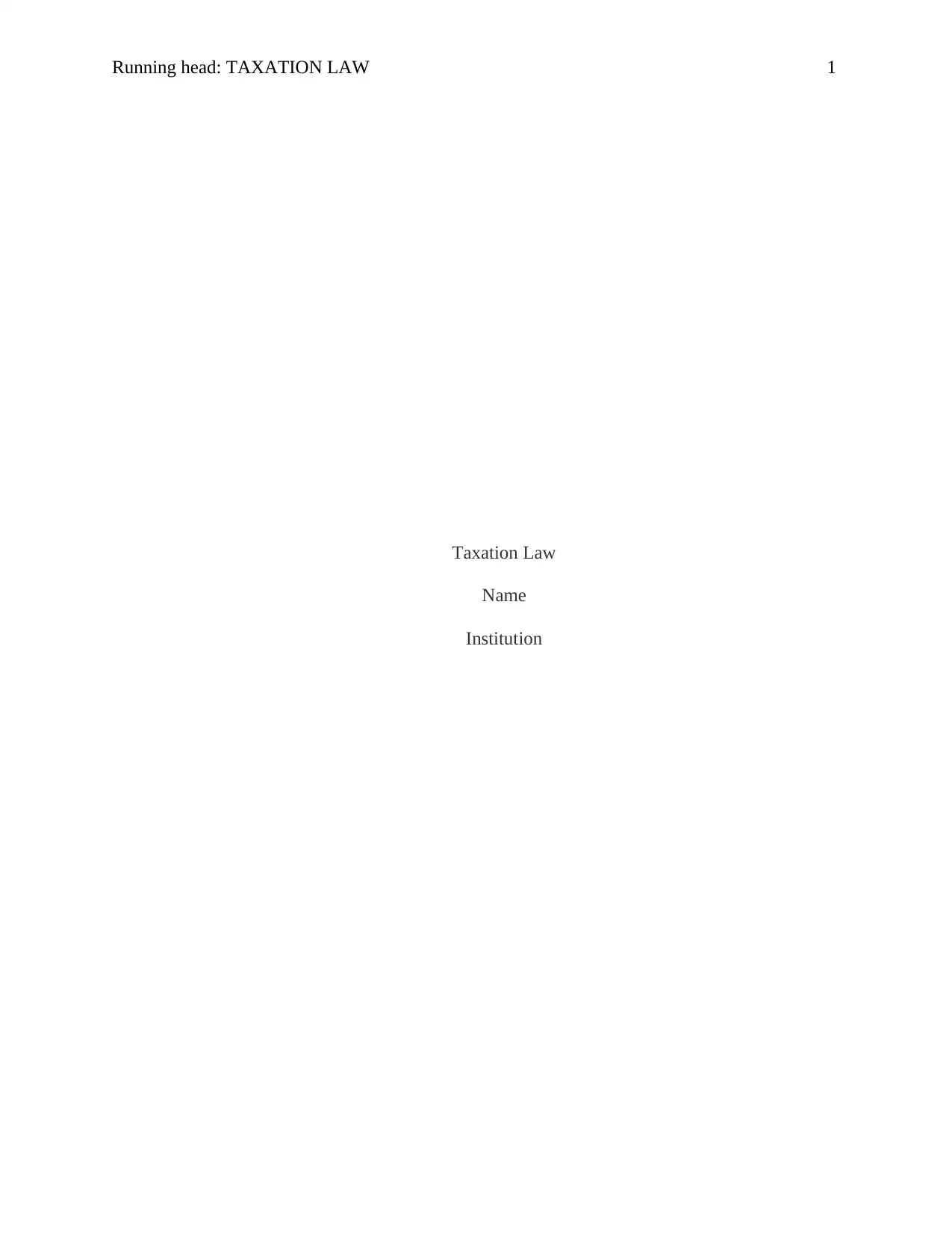
Running head: TAXATION LAW 1
Taxation Law
Name
Institution
Taxation Law
Name
Institution
Paraphrase This Document
Need a fresh take? Get an instant paraphrase of this document with our AI Paraphraser
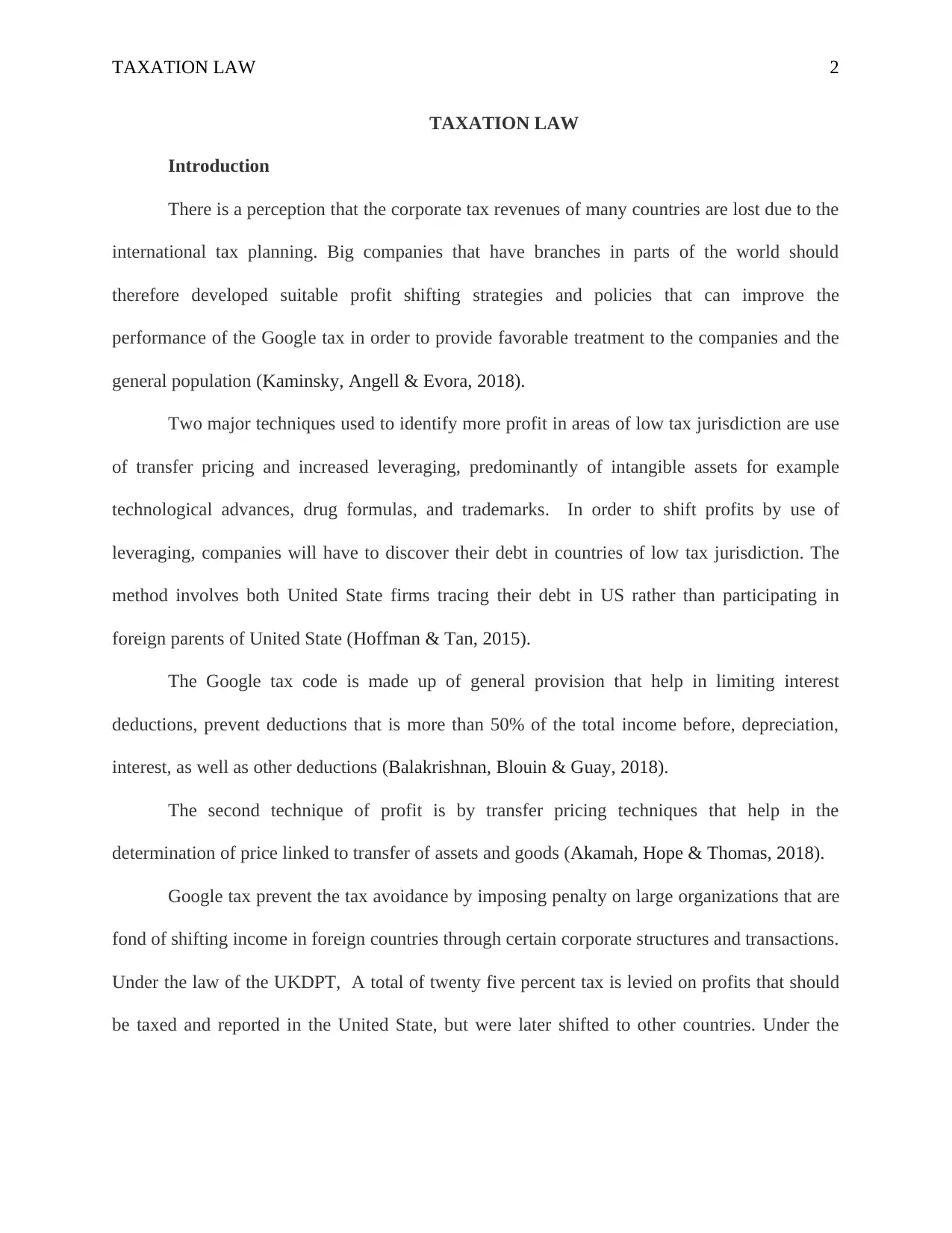
TAXATION LAW 2
TAXATION LAW
Introduction
There is a perception that the corporate tax revenues of many countries are lost due to the
international tax planning. Big companies that have branches in parts of the world should
therefore developed suitable profit shifting strategies and policies that can improve the
performance of the Google tax in order to provide favorable treatment to the companies and the
general population (Kaminsky, Angell & Evora, 2018).
Two major techniques used to identify more profit in areas of low tax jurisdiction are use
of transfer pricing and increased leveraging, predominantly of intangible assets for example
technological advances, drug formulas, and trademarks. In order to shift profits by use of
leveraging, companies will have to discover their debt in countries of low tax jurisdiction. The
method involves both United State firms tracing their debt in US rather than participating in
foreign parents of United State (Hoffman & Tan, 2015).
The Google tax code is made up of general provision that help in limiting interest
deductions, prevent deductions that is more than 50% of the total income before, depreciation,
interest, as well as other deductions (Balakrishnan, Blouin & Guay, 2018).
The second technique of profit is by transfer pricing techniques that help in the
determination of price linked to transfer of assets and goods (Akamah, Hope & Thomas, 2018).
Google tax prevent the tax avoidance by imposing penalty on large organizations that are
fond of shifting income in foreign countries through certain corporate structures and transactions.
Under the law of the UKDPT, A total of twenty five percent tax is levied on profits that should
be taxed and reported in the United State, but were later shifted to other countries. Under the
TAXATION LAW
Introduction
There is a perception that the corporate tax revenues of many countries are lost due to the
international tax planning. Big companies that have branches in parts of the world should
therefore developed suitable profit shifting strategies and policies that can improve the
performance of the Google tax in order to provide favorable treatment to the companies and the
general population (Kaminsky, Angell & Evora, 2018).
Two major techniques used to identify more profit in areas of low tax jurisdiction are use
of transfer pricing and increased leveraging, predominantly of intangible assets for example
technological advances, drug formulas, and trademarks. In order to shift profits by use of
leveraging, companies will have to discover their debt in countries of low tax jurisdiction. The
method involves both United State firms tracing their debt in US rather than participating in
foreign parents of United State (Hoffman & Tan, 2015).
The Google tax code is made up of general provision that help in limiting interest
deductions, prevent deductions that is more than 50% of the total income before, depreciation,
interest, as well as other deductions (Balakrishnan, Blouin & Guay, 2018).
The second technique of profit is by transfer pricing techniques that help in the
determination of price linked to transfer of assets and goods (Akamah, Hope & Thomas, 2018).
Google tax prevent the tax avoidance by imposing penalty on large organizations that are
fond of shifting income in foreign countries through certain corporate structures and transactions.
Under the law of the UKDPT, A total of twenty five percent tax is levied on profits that should
be taxed and reported in the United State, but were later shifted to other countries. Under the
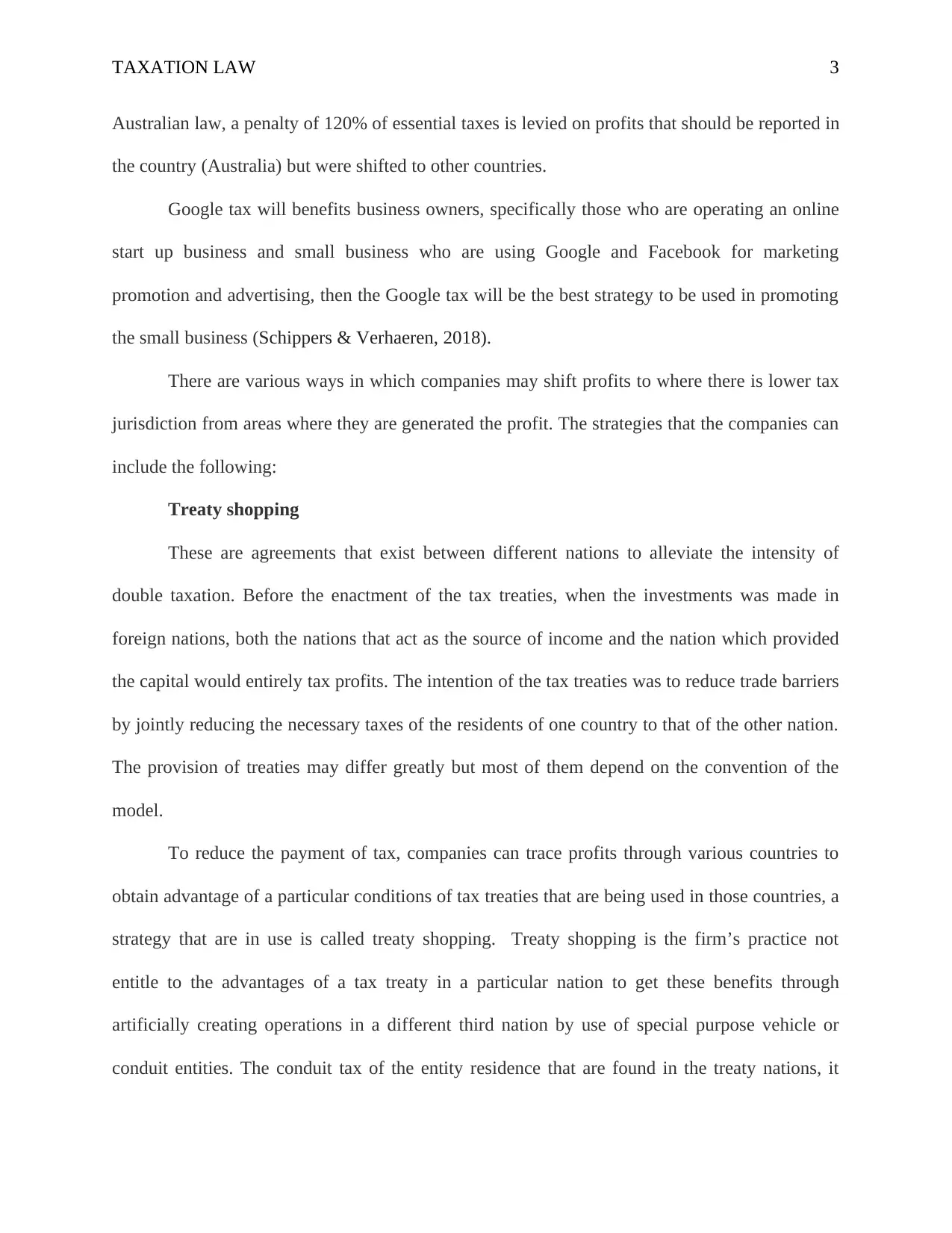
TAXATION LAW 3
Australian law, a penalty of 120% of essential taxes is levied on profits that should be reported in
the country (Australia) but were shifted to other countries.
Google tax will benefits business owners, specifically those who are operating an online
start up business and small business who are using Google and Facebook for marketing
promotion and advertising, then the Google tax will be the best strategy to be used in promoting
the small business (Schippers & Verhaeren, 2018).
There are various ways in which companies may shift profits to where there is lower tax
jurisdiction from areas where they are generated the profit. The strategies that the companies can
include the following:
Treaty shopping
These are agreements that exist between different nations to alleviate the intensity of
double taxation. Before the enactment of the tax treaties, when the investments was made in
foreign nations, both the nations that act as the source of income and the nation which provided
the capital would entirely tax profits. The intention of the tax treaties was to reduce trade barriers
by jointly reducing the necessary taxes of the residents of one country to that of the other nation.
The provision of treaties may differ greatly but most of them depend on the convention of the
model.
To reduce the payment of tax, companies can trace profits through various countries to
obtain advantage of a particular conditions of tax treaties that are being used in those countries, a
strategy that are in use is called treaty shopping. Treaty shopping is the firm’s practice not
entitle to the advantages of a tax treaty in a particular nation to get these benefits through
artificially creating operations in a different third nation by use of special purpose vehicle or
conduit entities. The conduit tax of the entity residence that are found in the treaty nations, it
Australian law, a penalty of 120% of essential taxes is levied on profits that should be reported in
the country (Australia) but were shifted to other countries.
Google tax will benefits business owners, specifically those who are operating an online
start up business and small business who are using Google and Facebook for marketing
promotion and advertising, then the Google tax will be the best strategy to be used in promoting
the small business (Schippers & Verhaeren, 2018).
There are various ways in which companies may shift profits to where there is lower tax
jurisdiction from areas where they are generated the profit. The strategies that the companies can
include the following:
Treaty shopping
These are agreements that exist between different nations to alleviate the intensity of
double taxation. Before the enactment of the tax treaties, when the investments was made in
foreign nations, both the nations that act as the source of income and the nation which provided
the capital would entirely tax profits. The intention of the tax treaties was to reduce trade barriers
by jointly reducing the necessary taxes of the residents of one country to that of the other nation.
The provision of treaties may differ greatly but most of them depend on the convention of the
model.
To reduce the payment of tax, companies can trace profits through various countries to
obtain advantage of a particular conditions of tax treaties that are being used in those countries, a
strategy that are in use is called treaty shopping. Treaty shopping is the firm’s practice not
entitle to the advantages of a tax treaty in a particular nation to get these benefits through
artificially creating operations in a different third nation by use of special purpose vehicle or
conduit entities. The conduit tax of the entity residence that are found in the treaty nations, it
⊘ This is a preview!⊘
Do you want full access?
Subscribe today to unlock all pages.

Trusted by 1+ million students worldwide
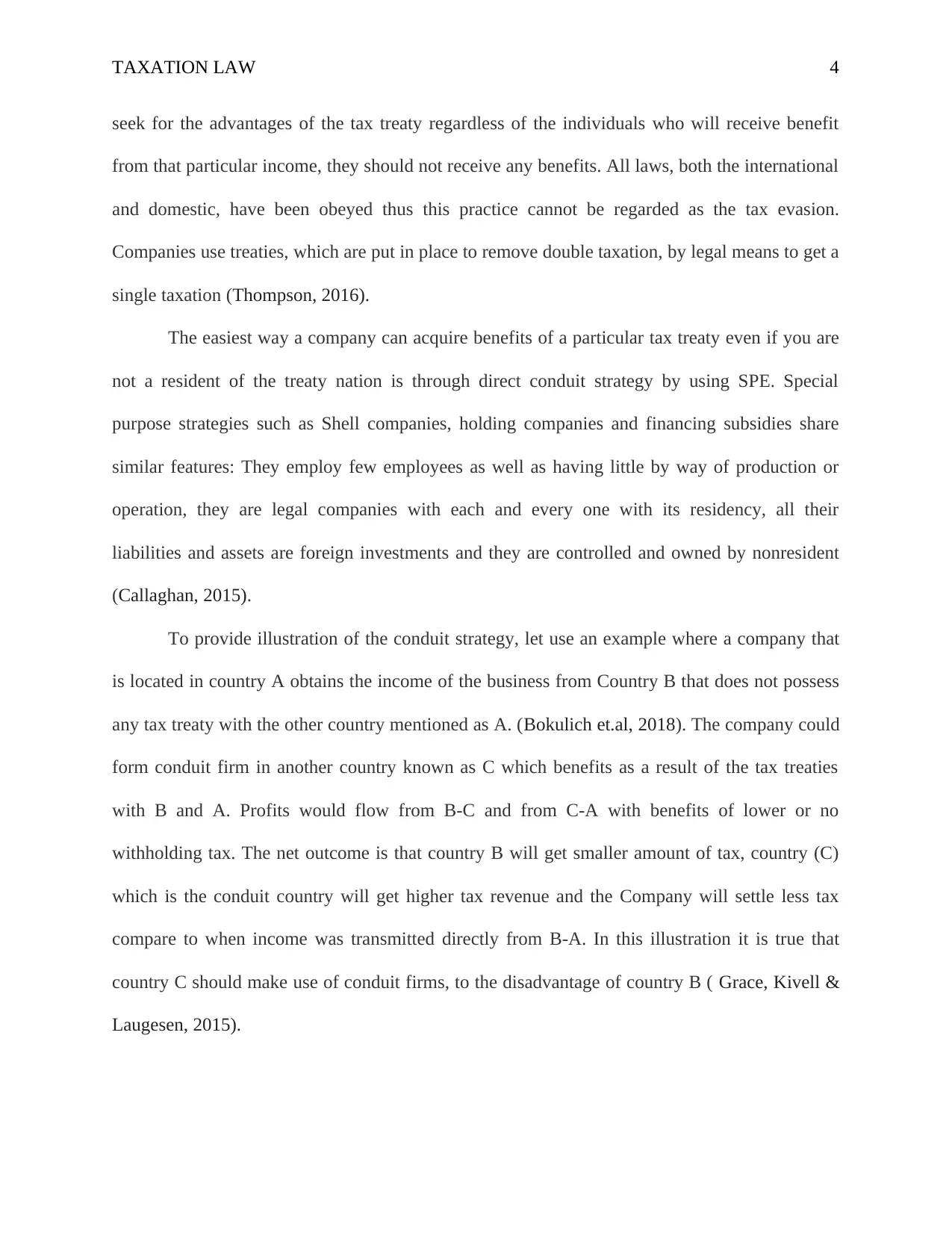
TAXATION LAW 4
seek for the advantages of the tax treaty regardless of the individuals who will receive benefit
from that particular income, they should not receive any benefits. All laws, both the international
and domestic, have been obeyed thus this practice cannot be regarded as the tax evasion.
Companies use treaties, which are put in place to remove double taxation, by legal means to get a
single taxation (Thompson, 2016).
The easiest way a company can acquire benefits of a particular tax treaty even if you are
not a resident of the treaty nation is through direct conduit strategy by using SPE. Special
purpose strategies such as Shell companies, holding companies and financing subsidies share
similar features: They employ few employees as well as having little by way of production or
operation, they are legal companies with each and every one with its residency, all their
liabilities and assets are foreign investments and they are controlled and owned by nonresident
(Callaghan, 2015).
To provide illustration of the conduit strategy, let use an example where a company that
is located in country A obtains the income of the business from Country B that does not possess
any tax treaty with the other country mentioned as A. (Bokulich et.al, 2018). The company could
form conduit firm in another country known as C which benefits as a result of the tax treaties
with B and A. Profits would flow from B-C and from C-A with benefits of lower or no
withholding tax. The net outcome is that country B will get smaller amount of tax, country (C)
which is the conduit country will get higher tax revenue and the Company will settle less tax
compare to when income was transmitted directly from B-A. In this illustration it is true that
country C should make use of conduit firms, to the disadvantage of country B ( Grace, Kivell &
Laugesen, 2015).
seek for the advantages of the tax treaty regardless of the individuals who will receive benefit
from that particular income, they should not receive any benefits. All laws, both the international
and domestic, have been obeyed thus this practice cannot be regarded as the tax evasion.
Companies use treaties, which are put in place to remove double taxation, by legal means to get a
single taxation (Thompson, 2016).
The easiest way a company can acquire benefits of a particular tax treaty even if you are
not a resident of the treaty nation is through direct conduit strategy by using SPE. Special
purpose strategies such as Shell companies, holding companies and financing subsidies share
similar features: They employ few employees as well as having little by way of production or
operation, they are legal companies with each and every one with its residency, all their
liabilities and assets are foreign investments and they are controlled and owned by nonresident
(Callaghan, 2015).
To provide illustration of the conduit strategy, let use an example where a company that
is located in country A obtains the income of the business from Country B that does not possess
any tax treaty with the other country mentioned as A. (Bokulich et.al, 2018). The company could
form conduit firm in another country known as C which benefits as a result of the tax treaties
with B and A. Profits would flow from B-C and from C-A with benefits of lower or no
withholding tax. The net outcome is that country B will get smaller amount of tax, country (C)
which is the conduit country will get higher tax revenue and the Company will settle less tax
compare to when income was transmitted directly from B-A. In this illustration it is true that
country C should make use of conduit firms, to the disadvantage of country B ( Grace, Kivell &
Laugesen, 2015).
Paraphrase This Document
Need a fresh take? Get an instant paraphrase of this document with our AI Paraphraser
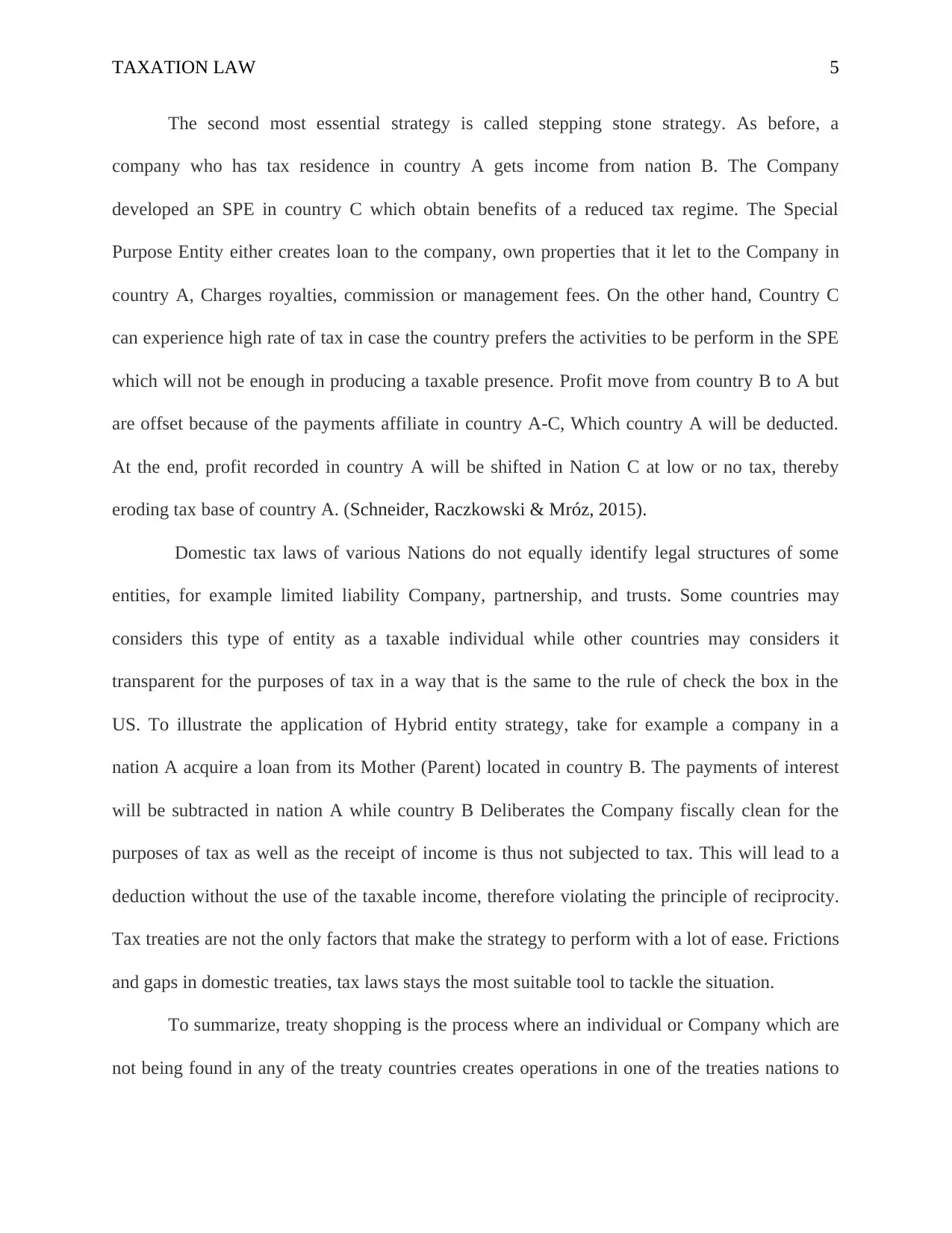
TAXATION LAW 5
The second most essential strategy is called stepping stone strategy. As before, a
company who has tax residence in country A gets income from nation B. The Company
developed an SPE in country C which obtain benefits of a reduced tax regime. The Special
Purpose Entity either creates loan to the company, own properties that it let to the Company in
country A, Charges royalties, commission or management fees. On the other hand, Country C
can experience high rate of tax in case the country prefers the activities to be perform in the SPE
which will not be enough in producing a taxable presence. Profit move from country B to A but
are offset because of the payments affiliate in country A-C, Which country A will be deducted.
At the end, profit recorded in country A will be shifted in Nation C at low or no tax, thereby
eroding tax base of country A. (Schneider, Raczkowski & Mróz, 2015).
Domestic tax laws of various Nations do not equally identify legal structures of some
entities, for example limited liability Company, partnership, and trusts. Some countries may
considers this type of entity as a taxable individual while other countries may considers it
transparent for the purposes of tax in a way that is the same to the rule of check the box in the
US. To illustrate the application of Hybrid entity strategy, take for example a company in a
nation A acquire a loan from its Mother (Parent) located in country B. The payments of interest
will be subtracted in nation A while country B Deliberates the Company fiscally clean for the
purposes of tax as well as the receipt of income is thus not subjected to tax. This will lead to a
deduction without the use of the taxable income, therefore violating the principle of reciprocity.
Tax treaties are not the only factors that make the strategy to perform with a lot of ease. Frictions
and gaps in domestic treaties, tax laws stays the most suitable tool to tackle the situation.
To summarize, treaty shopping is the process where an individual or Company which are
not being found in any of the treaty countries creates operations in one of the treaties nations to
The second most essential strategy is called stepping stone strategy. As before, a
company who has tax residence in country A gets income from nation B. The Company
developed an SPE in country C which obtain benefits of a reduced tax regime. The Special
Purpose Entity either creates loan to the company, own properties that it let to the Company in
country A, Charges royalties, commission or management fees. On the other hand, Country C
can experience high rate of tax in case the country prefers the activities to be perform in the SPE
which will not be enough in producing a taxable presence. Profit move from country B to A but
are offset because of the payments affiliate in country A-C, Which country A will be deducted.
At the end, profit recorded in country A will be shifted in Nation C at low or no tax, thereby
eroding tax base of country A. (Schneider, Raczkowski & Mróz, 2015).
Domestic tax laws of various Nations do not equally identify legal structures of some
entities, for example limited liability Company, partnership, and trusts. Some countries may
considers this type of entity as a taxable individual while other countries may considers it
transparent for the purposes of tax in a way that is the same to the rule of check the box in the
US. To illustrate the application of Hybrid entity strategy, take for example a company in a
nation A acquire a loan from its Mother (Parent) located in country B. The payments of interest
will be subtracted in nation A while country B Deliberates the Company fiscally clean for the
purposes of tax as well as the receipt of income is thus not subjected to tax. This will lead to a
deduction without the use of the taxable income, therefore violating the principle of reciprocity.
Tax treaties are not the only factors that make the strategy to perform with a lot of ease. Frictions
and gaps in domestic treaties, tax laws stays the most suitable tool to tackle the situation.
To summarize, treaty shopping is the process where an individual or Company which are
not being found in any of the treaty countries creates operations in one of the treaties nations to
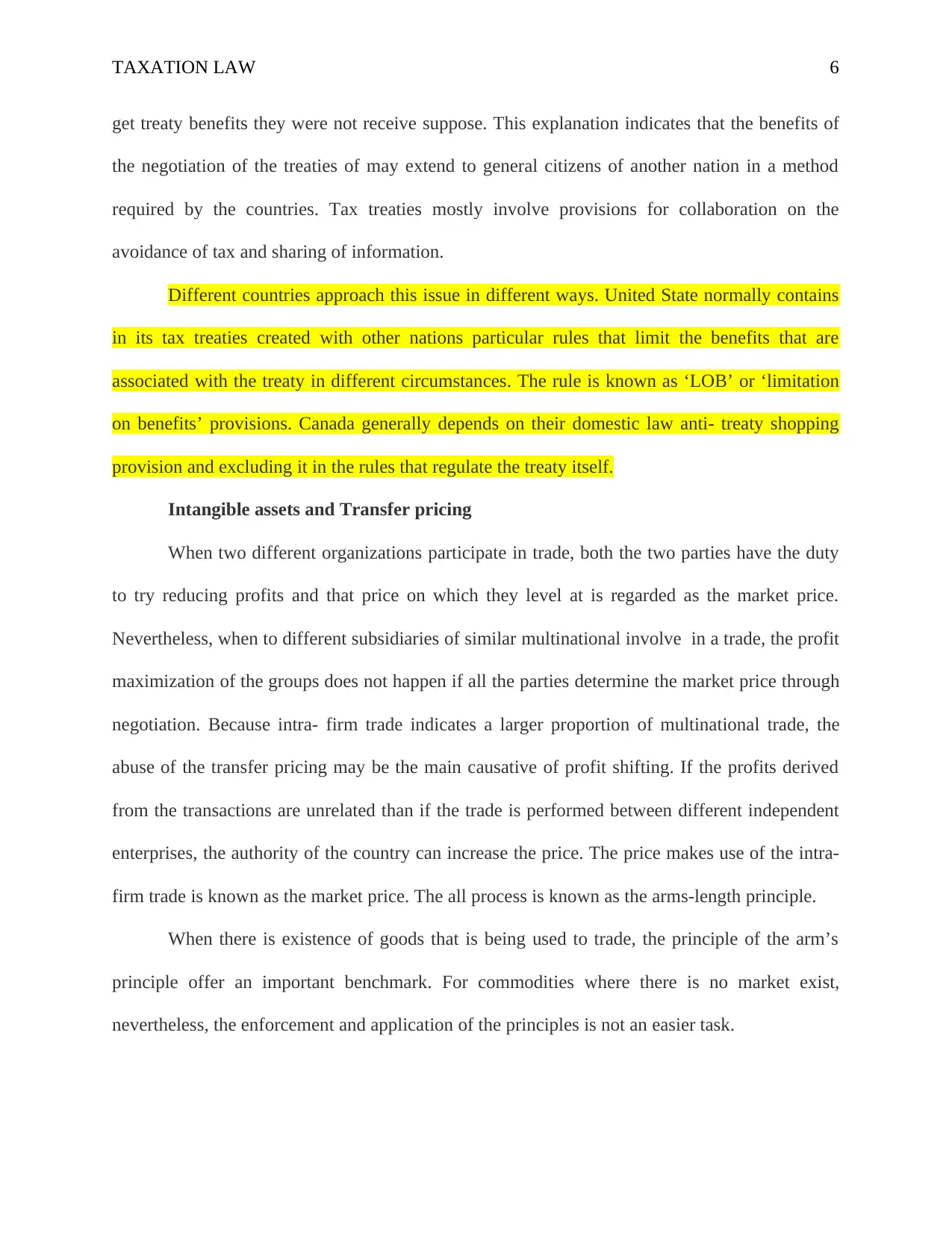
TAXATION LAW 6
get treaty benefits they were not receive suppose. This explanation indicates that the benefits of
the negotiation of the treaties of may extend to general citizens of another nation in a method
required by the countries. Tax treaties mostly involve provisions for collaboration on the
avoidance of tax and sharing of information.
Different countries approach this issue in different ways. United State normally contains
in its tax treaties created with other nations particular rules that limit the benefits that are
associated with the treaty in different circumstances. The rule is known as ‘LOB’ or ‘limitation
on benefits’ provisions. Canada generally depends on their domestic law anti- treaty shopping
provision and excluding it in the rules that regulate the treaty itself.
Intangible assets and Transfer pricing
When two different organizations participate in trade, both the two parties have the duty
to try reducing profits and that price on which they level at is regarded as the market price.
Nevertheless, when to different subsidiaries of similar multinational involve in a trade, the profit
maximization of the groups does not happen if all the parties determine the market price through
negotiation. Because intra- firm trade indicates a larger proportion of multinational trade, the
abuse of the transfer pricing may be the main causative of profit shifting. If the profits derived
from the transactions are unrelated than if the trade is performed between different independent
enterprises, the authority of the country can increase the price. The price makes use of the intra-
firm trade is known as the market price. The all process is known as the arms-length principle.
When there is existence of goods that is being used to trade, the principle of the arm’s
principle offer an important benchmark. For commodities where there is no market exist,
nevertheless, the enforcement and application of the principles is not an easier task.
get treaty benefits they were not receive suppose. This explanation indicates that the benefits of
the negotiation of the treaties of may extend to general citizens of another nation in a method
required by the countries. Tax treaties mostly involve provisions for collaboration on the
avoidance of tax and sharing of information.
Different countries approach this issue in different ways. United State normally contains
in its tax treaties created with other nations particular rules that limit the benefits that are
associated with the treaty in different circumstances. The rule is known as ‘LOB’ or ‘limitation
on benefits’ provisions. Canada generally depends on their domestic law anti- treaty shopping
provision and excluding it in the rules that regulate the treaty itself.
Intangible assets and Transfer pricing
When two different organizations participate in trade, both the two parties have the duty
to try reducing profits and that price on which they level at is regarded as the market price.
Nevertheless, when to different subsidiaries of similar multinational involve in a trade, the profit
maximization of the groups does not happen if all the parties determine the market price through
negotiation. Because intra- firm trade indicates a larger proportion of multinational trade, the
abuse of the transfer pricing may be the main causative of profit shifting. If the profits derived
from the transactions are unrelated than if the trade is performed between different independent
enterprises, the authority of the country can increase the price. The price makes use of the intra-
firm trade is known as the market price. The all process is known as the arms-length principle.
When there is existence of goods that is being used to trade, the principle of the arm’s
principle offer an important benchmark. For commodities where there is no market exist,
nevertheless, the enforcement and application of the principles is not an easier task.
⊘ This is a preview!⊘
Do you want full access?
Subscribe today to unlock all pages.

Trusted by 1+ million students worldwide
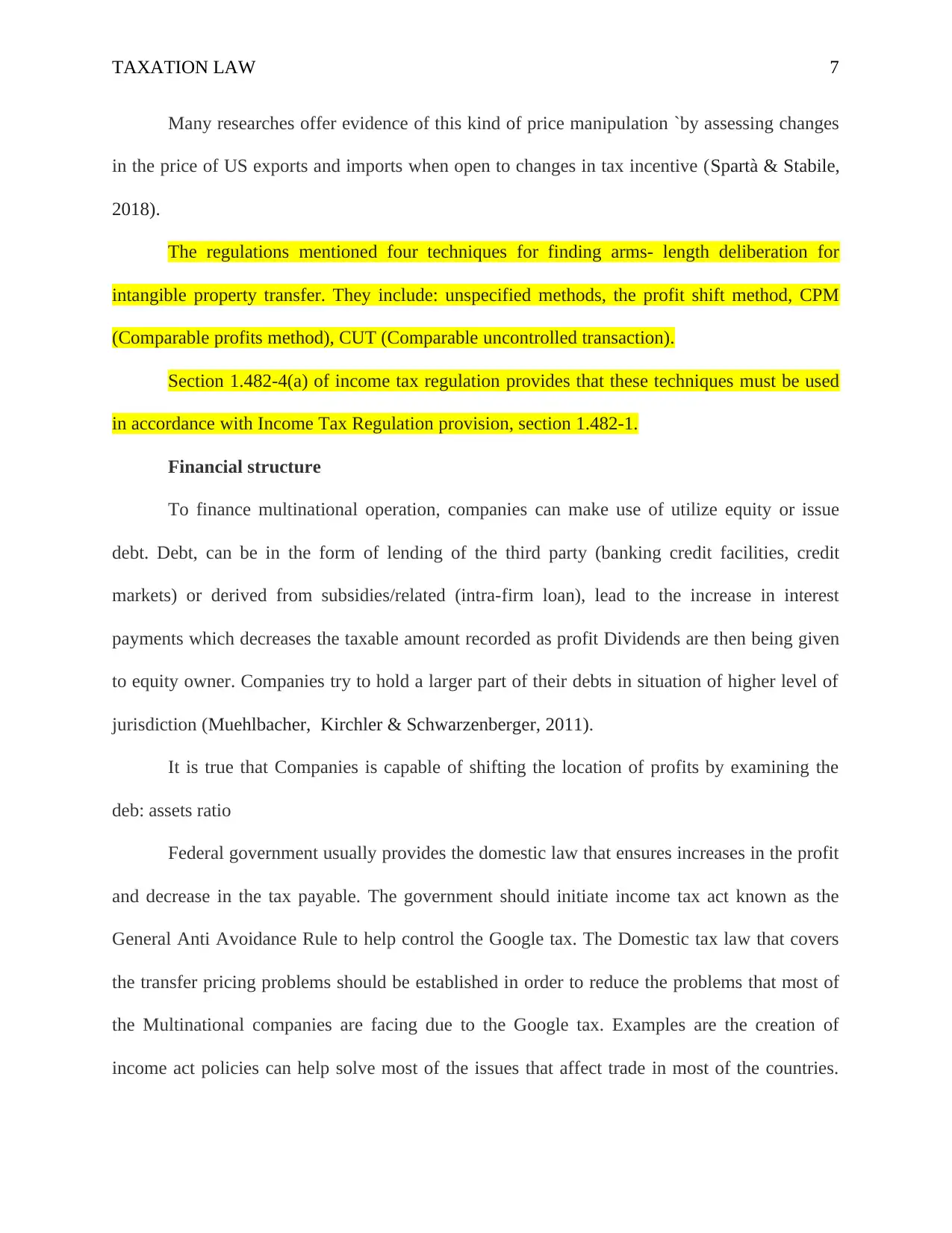
TAXATION LAW 7
Many researches offer evidence of this kind of price manipulation `by assessing changes
in the price of US exports and imports when open to changes in tax incentive (Spartà & Stabile,
2018).
The regulations mentioned four techniques for finding arms- length deliberation for
intangible property transfer. They include: unspecified methods, the profit shift method, CPM
(Comparable profits method), CUT (Comparable uncontrolled transaction).
Section 1.482-4(a) of income tax regulation provides that these techniques must be used
in accordance with Income Tax Regulation provision, section 1.482-1.
Financial structure
To finance multinational operation, companies can make use of utilize equity or issue
debt. Debt, can be in the form of lending of the third party (banking credit facilities, credit
markets) or derived from subsidies/related (intra-firm loan), lead to the increase in interest
payments which decreases the taxable amount recorded as profit Dividends are then being given
to equity owner. Companies try to hold a larger part of their debts in situation of higher level of
jurisdiction (Muehlbacher, Kirchler & Schwarzenberger, 2011).
It is true that Companies is capable of shifting the location of profits by examining the
deb: assets ratio
Federal government usually provides the domestic law that ensures increases in the profit
and decrease in the tax payable. The government should initiate income tax act known as the
General Anti Avoidance Rule to help control the Google tax. The Domestic tax law that covers
the transfer pricing problems should be established in order to reduce the problems that most of
the Multinational companies are facing due to the Google tax. Examples are the creation of
income act policies can help solve most of the issues that affect trade in most of the countries.
Many researches offer evidence of this kind of price manipulation `by assessing changes
in the price of US exports and imports when open to changes in tax incentive (Spartà & Stabile,
2018).
The regulations mentioned four techniques for finding arms- length deliberation for
intangible property transfer. They include: unspecified methods, the profit shift method, CPM
(Comparable profits method), CUT (Comparable uncontrolled transaction).
Section 1.482-4(a) of income tax regulation provides that these techniques must be used
in accordance with Income Tax Regulation provision, section 1.482-1.
Financial structure
To finance multinational operation, companies can make use of utilize equity or issue
debt. Debt, can be in the form of lending of the third party (banking credit facilities, credit
markets) or derived from subsidies/related (intra-firm loan), lead to the increase in interest
payments which decreases the taxable amount recorded as profit Dividends are then being given
to equity owner. Companies try to hold a larger part of their debts in situation of higher level of
jurisdiction (Muehlbacher, Kirchler & Schwarzenberger, 2011).
It is true that Companies is capable of shifting the location of profits by examining the
deb: assets ratio
Federal government usually provides the domestic law that ensures increases in the profit
and decrease in the tax payable. The government should initiate income tax act known as the
General Anti Avoidance Rule to help control the Google tax. The Domestic tax law that covers
the transfer pricing problems should be established in order to reduce the problems that most of
the Multinational companies are facing due to the Google tax. Examples are the creation of
income act policies can help solve most of the issues that affect trade in most of the countries.
Paraphrase This Document
Need a fresh take? Get an instant paraphrase of this document with our AI Paraphraser
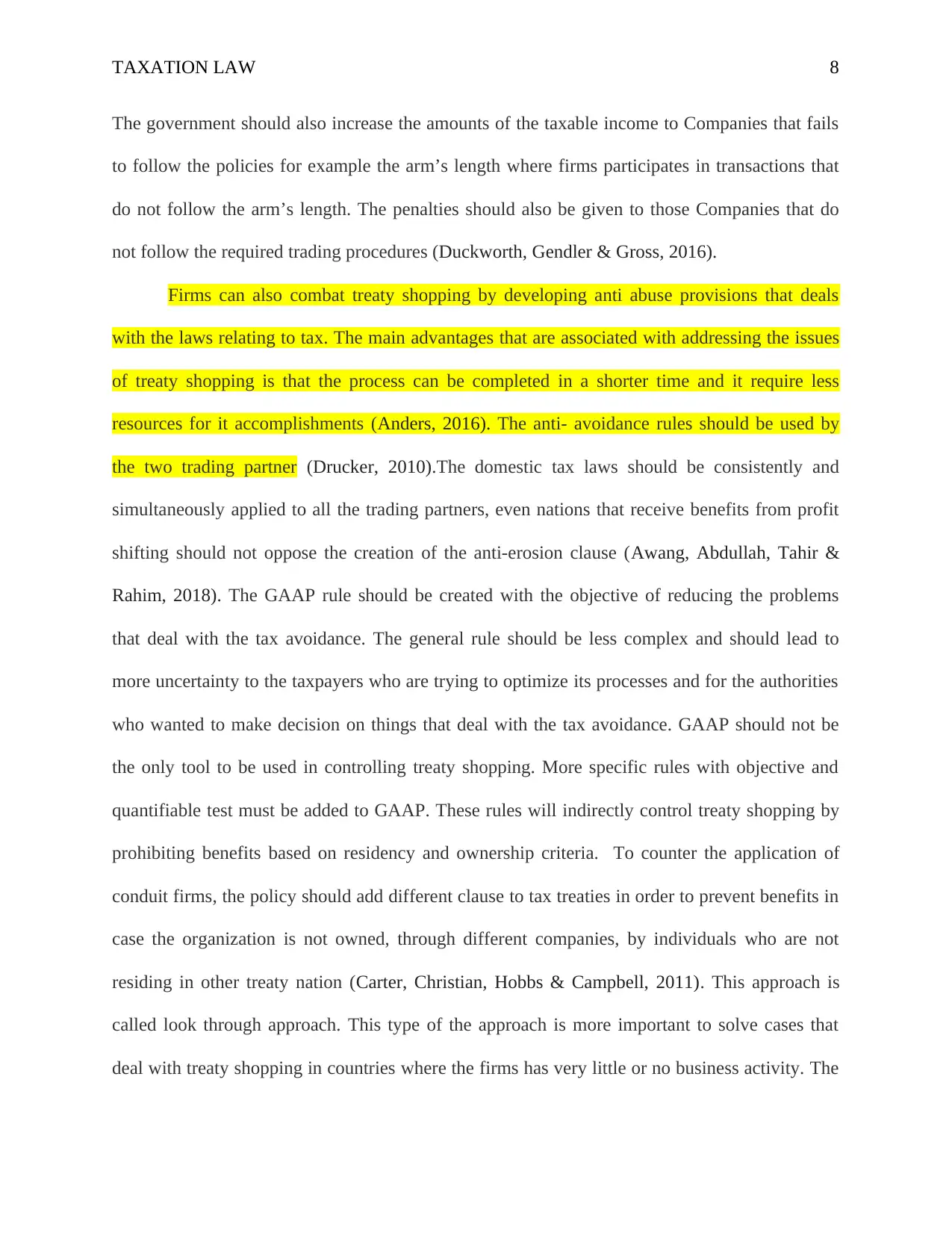
TAXATION LAW 8
The government should also increase the amounts of the taxable income to Companies that fails
to follow the policies for example the arm’s length where firms participates in transactions that
do not follow the arm’s length. The penalties should also be given to those Companies that do
not follow the required trading procedures (Duckworth, Gendler & Gross, 2016).
Firms can also combat treaty shopping by developing anti abuse provisions that deals
with the laws relating to tax. The main advantages that are associated with addressing the issues
of treaty shopping is that the process can be completed in a shorter time and it require less
resources for it accomplishments (Anders, 2016). The anti- avoidance rules should be used by
the two trading partner (Drucker, 2010).The domestic tax laws should be consistently and
simultaneously applied to all the trading partners, even nations that receive benefits from profit
shifting should not oppose the creation of the anti-erosion clause (Awang, Abdullah, Tahir &
Rahim, 2018). The GAAP rule should be created with the objective of reducing the problems
that deal with the tax avoidance. The general rule should be less complex and should lead to
more uncertainty to the taxpayers who are trying to optimize its processes and for the authorities
who wanted to make decision on things that deal with the tax avoidance. GAAP should not be
the only tool to be used in controlling treaty shopping. More specific rules with objective and
quantifiable test must be added to GAAP. These rules will indirectly control treaty shopping by
prohibiting benefits based on residency and ownership criteria. To counter the application of
conduit firms, the policy should add different clause to tax treaties in order to prevent benefits in
case the organization is not owned, through different companies, by individuals who are not
residing in other treaty nation (Carter, Christian, Hobbs & Campbell, 2011). This approach is
called look through approach. This type of the approach is more important to solve cases that
deal with treaty shopping in countries where the firms has very little or no business activity. The
The government should also increase the amounts of the taxable income to Companies that fails
to follow the policies for example the arm’s length where firms participates in transactions that
do not follow the arm’s length. The penalties should also be given to those Companies that do
not follow the required trading procedures (Duckworth, Gendler & Gross, 2016).
Firms can also combat treaty shopping by developing anti abuse provisions that deals
with the laws relating to tax. The main advantages that are associated with addressing the issues
of treaty shopping is that the process can be completed in a shorter time and it require less
resources for it accomplishments (Anders, 2016). The anti- avoidance rules should be used by
the two trading partner (Drucker, 2010).The domestic tax laws should be consistently and
simultaneously applied to all the trading partners, even nations that receive benefits from profit
shifting should not oppose the creation of the anti-erosion clause (Awang, Abdullah, Tahir &
Rahim, 2018). The GAAP rule should be created with the objective of reducing the problems
that deal with the tax avoidance. The general rule should be less complex and should lead to
more uncertainty to the taxpayers who are trying to optimize its processes and for the authorities
who wanted to make decision on things that deal with the tax avoidance. GAAP should not be
the only tool to be used in controlling treaty shopping. More specific rules with objective and
quantifiable test must be added to GAAP. These rules will indirectly control treaty shopping by
prohibiting benefits based on residency and ownership criteria. To counter the application of
conduit firms, the policy should add different clause to tax treaties in order to prevent benefits in
case the organization is not owned, through different companies, by individuals who are not
residing in other treaty nation (Carter, Christian, Hobbs & Campbell, 2011). This approach is
called look through approach. This type of the approach is more important to solve cases that
deal with treaty shopping in countries where the firms has very little or no business activity. The
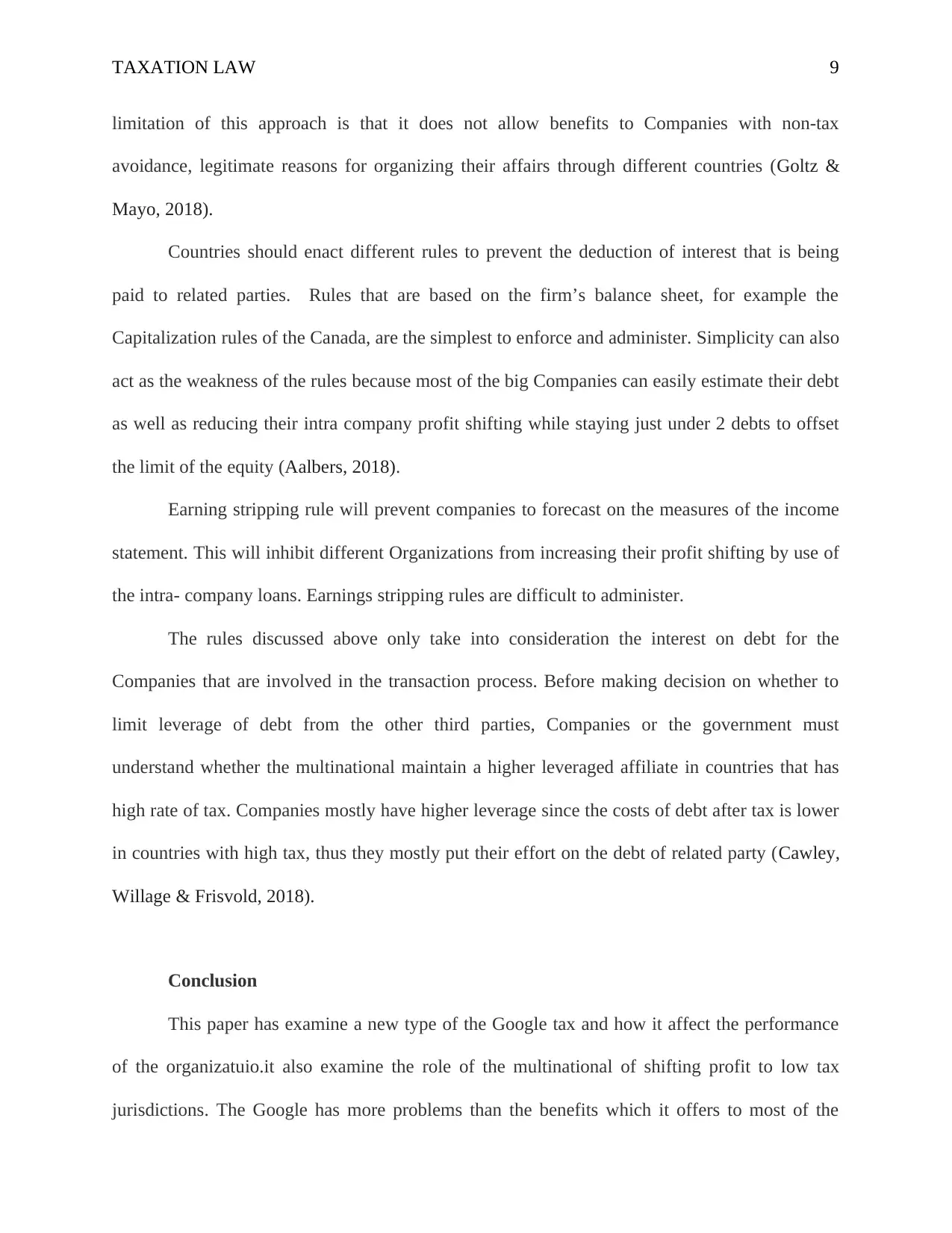
TAXATION LAW 9
limitation of this approach is that it does not allow benefits to Companies with non-tax
avoidance, legitimate reasons for organizing their affairs through different countries (Goltz &
Mayo, 2018).
Countries should enact different rules to prevent the deduction of interest that is being
paid to related parties. Rules that are based on the firm’s balance sheet, for example the
Capitalization rules of the Canada, are the simplest to enforce and administer. Simplicity can also
act as the weakness of the rules because most of the big Companies can easily estimate their debt
as well as reducing their intra company profit shifting while staying just under 2 debts to offset
the limit of the equity (Aalbers, 2018).
Earning stripping rule will prevent companies to forecast on the measures of the income
statement. This will inhibit different Organizations from increasing their profit shifting by use of
the intra- company loans. Earnings stripping rules are difficult to administer.
The rules discussed above only take into consideration the interest on debt for the
Companies that are involved in the transaction process. Before making decision on whether to
limit leverage of debt from the other third parties, Companies or the government must
understand whether the multinational maintain a higher leveraged affiliate in countries that has
high rate of tax. Companies mostly have higher leverage since the costs of debt after tax is lower
in countries with high tax, thus they mostly put their effort on the debt of related party (Cawley,
Willage & Frisvold, 2018).
Conclusion
This paper has examine a new type of the Google tax and how it affect the performance
of the organizatuio.it also examine the role of the multinational of shifting profit to low tax
jurisdictions. The Google has more problems than the benefits which it offers to most of the
limitation of this approach is that it does not allow benefits to Companies with non-tax
avoidance, legitimate reasons for organizing their affairs through different countries (Goltz &
Mayo, 2018).
Countries should enact different rules to prevent the deduction of interest that is being
paid to related parties. Rules that are based on the firm’s balance sheet, for example the
Capitalization rules of the Canada, are the simplest to enforce and administer. Simplicity can also
act as the weakness of the rules because most of the big Companies can easily estimate their debt
as well as reducing their intra company profit shifting while staying just under 2 debts to offset
the limit of the equity (Aalbers, 2018).
Earning stripping rule will prevent companies to forecast on the measures of the income
statement. This will inhibit different Organizations from increasing their profit shifting by use of
the intra- company loans. Earnings stripping rules are difficult to administer.
The rules discussed above only take into consideration the interest on debt for the
Companies that are involved in the transaction process. Before making decision on whether to
limit leverage of debt from the other third parties, Companies or the government must
understand whether the multinational maintain a higher leveraged affiliate in countries that has
high rate of tax. Companies mostly have higher leverage since the costs of debt after tax is lower
in countries with high tax, thus they mostly put their effort on the debt of related party (Cawley,
Willage & Frisvold, 2018).
Conclusion
This paper has examine a new type of the Google tax and how it affect the performance
of the organizatuio.it also examine the role of the multinational of shifting profit to low tax
jurisdictions. The Google has more problems than the benefits which it offers to most of the
⊘ This is a preview!⊘
Do you want full access?
Subscribe today to unlock all pages.

Trusted by 1+ million students worldwide
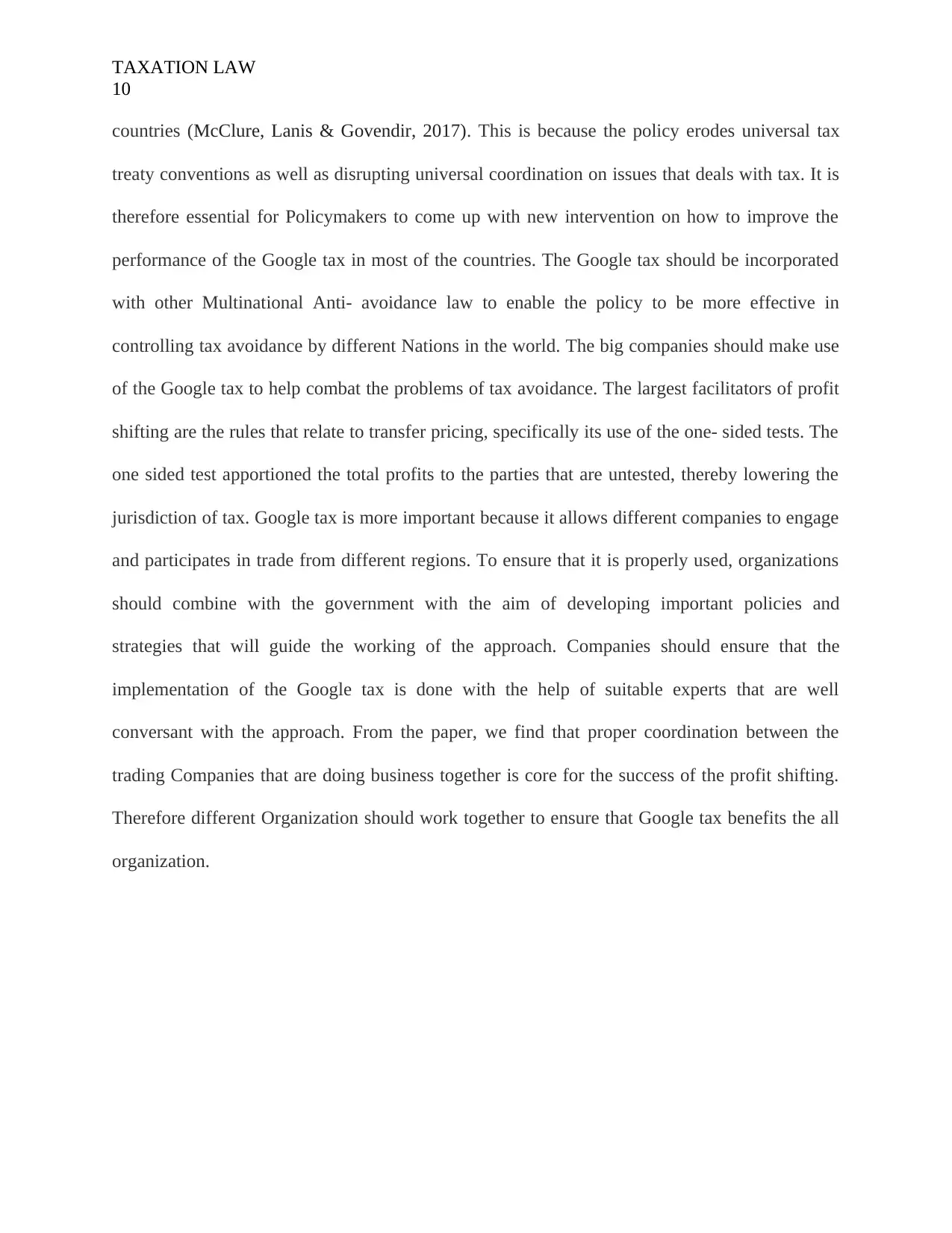
TAXATION LAW
10
countries (McClure, Lanis & Govendir, 2017). This is because the policy erodes universal tax
treaty conventions as well as disrupting universal coordination on issues that deals with tax. It is
therefore essential for Policymakers to come up with new intervention on how to improve the
performance of the Google tax in most of the countries. The Google tax should be incorporated
with other Multinational Anti- avoidance law to enable the policy to be more effective in
controlling tax avoidance by different Nations in the world. The big companies should make use
of the Google tax to help combat the problems of tax avoidance. The largest facilitators of profit
shifting are the rules that relate to transfer pricing, specifically its use of the one- sided tests. The
one sided test apportioned the total profits to the parties that are untested, thereby lowering the
jurisdiction of tax. Google tax is more important because it allows different companies to engage
and participates in trade from different regions. To ensure that it is properly used, organizations
should combine with the government with the aim of developing important policies and
strategies that will guide the working of the approach. Companies should ensure that the
implementation of the Google tax is done with the help of suitable experts that are well
conversant with the approach. From the paper, we find that proper coordination between the
trading Companies that are doing business together is core for the success of the profit shifting.
Therefore different Organization should work together to ensure that Google tax benefits the all
organization.
10
countries (McClure, Lanis & Govendir, 2017). This is because the policy erodes universal tax
treaty conventions as well as disrupting universal coordination on issues that deals with tax. It is
therefore essential for Policymakers to come up with new intervention on how to improve the
performance of the Google tax in most of the countries. The Google tax should be incorporated
with other Multinational Anti- avoidance law to enable the policy to be more effective in
controlling tax avoidance by different Nations in the world. The big companies should make use
of the Google tax to help combat the problems of tax avoidance. The largest facilitators of profit
shifting are the rules that relate to transfer pricing, specifically its use of the one- sided tests. The
one sided test apportioned the total profits to the parties that are untested, thereby lowering the
jurisdiction of tax. Google tax is more important because it allows different companies to engage
and participates in trade from different regions. To ensure that it is properly used, organizations
should combine with the government with the aim of developing important policies and
strategies that will guide the working of the approach. Companies should ensure that the
implementation of the Google tax is done with the help of suitable experts that are well
conversant with the approach. From the paper, we find that proper coordination between the
trading Companies that are doing business together is core for the success of the profit shifting.
Therefore different Organization should work together to ensure that Google tax benefits the all
organization.
Paraphrase This Document
Need a fresh take? Get an instant paraphrase of this document with our AI Paraphraser
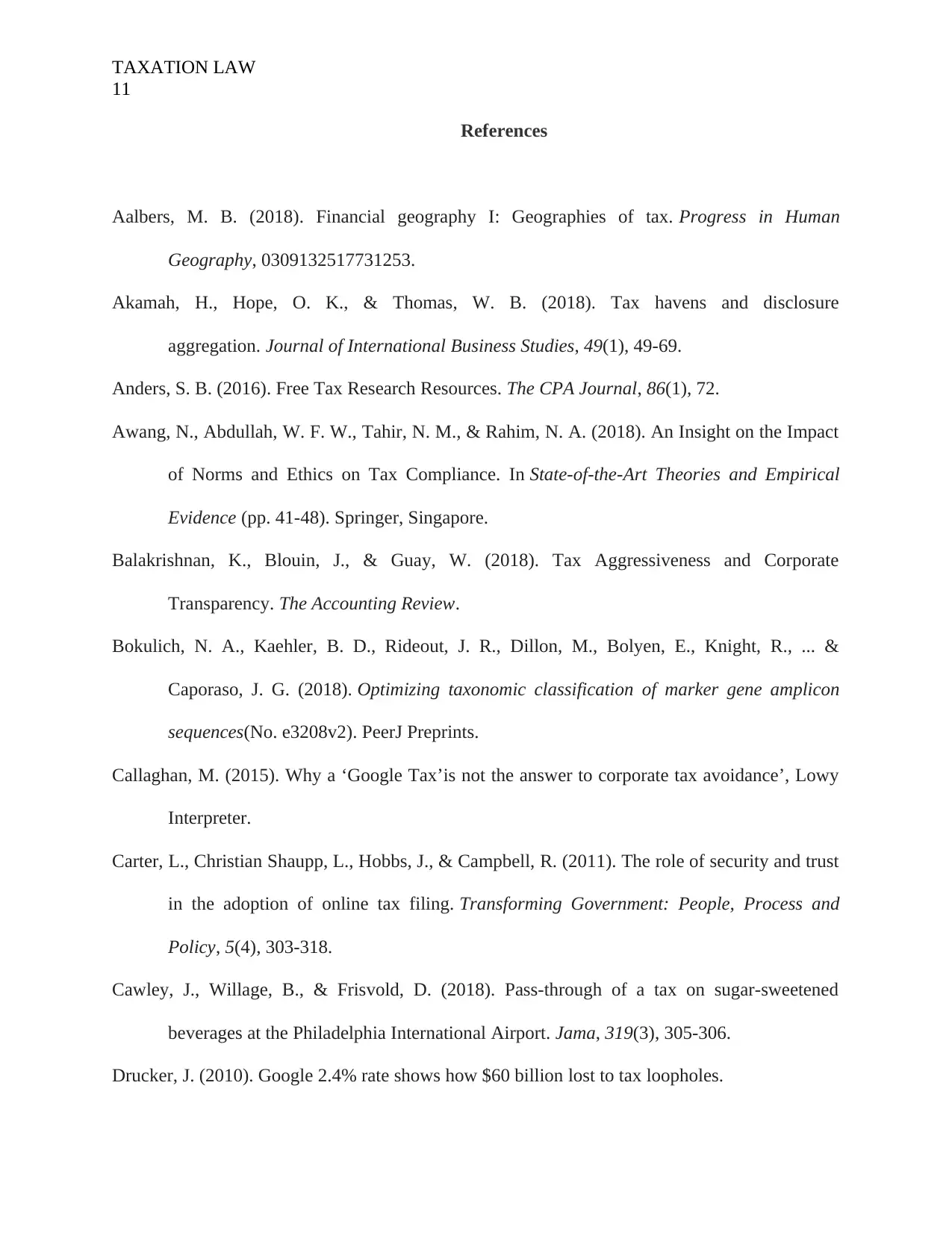
TAXATION LAW
11
References
Aalbers, M. B. (2018). Financial geography I: Geographies of tax. Progress in Human
Geography, 0309132517731253.
Akamah, H., Hope, O. K., & Thomas, W. B. (2018). Tax havens and disclosure
aggregation. Journal of International Business Studies, 49(1), 49-69.
Anders, S. B. (2016). Free Tax Research Resources. The CPA Journal, 86(1), 72.
Awang, N., Abdullah, W. F. W., Tahir, N. M., & Rahim, N. A. (2018). An Insight on the Impact
of Norms and Ethics on Tax Compliance. In State-of-the-Art Theories and Empirical
Evidence (pp. 41-48). Springer, Singapore.
Balakrishnan, K., Blouin, J., & Guay, W. (2018). Tax Aggressiveness and Corporate
Transparency. The Accounting Review.
Bokulich, N. A., Kaehler, B. D., Rideout, J. R., Dillon, M., Bolyen, E., Knight, R., ... &
Caporaso, J. G. (2018). Optimizing taxonomic classification of marker gene amplicon
sequences(No. e3208v2). PeerJ Preprints.
Callaghan, M. (2015). Why a ‘Google Tax’is not the answer to corporate tax avoidance’, Lowy
Interpreter.
Carter, L., Christian Shaupp, L., Hobbs, J., & Campbell, R. (2011). The role of security and trust
in the adoption of online tax filing. Transforming Government: People, Process and
Policy, 5(4), 303-318.
Cawley, J., Willage, B., & Frisvold, D. (2018). Pass-through of a tax on sugar-sweetened
beverages at the Philadelphia International Airport. Jama, 319(3), 305-306.
Drucker, J. (2010). Google 2.4% rate shows how $60 billion lost to tax loopholes.
11
References
Aalbers, M. B. (2018). Financial geography I: Geographies of tax. Progress in Human
Geography, 0309132517731253.
Akamah, H., Hope, O. K., & Thomas, W. B. (2018). Tax havens and disclosure
aggregation. Journal of International Business Studies, 49(1), 49-69.
Anders, S. B. (2016). Free Tax Research Resources. The CPA Journal, 86(1), 72.
Awang, N., Abdullah, W. F. W., Tahir, N. M., & Rahim, N. A. (2018). An Insight on the Impact
of Norms and Ethics on Tax Compliance. In State-of-the-Art Theories and Empirical
Evidence (pp. 41-48). Springer, Singapore.
Balakrishnan, K., Blouin, J., & Guay, W. (2018). Tax Aggressiveness and Corporate
Transparency. The Accounting Review.
Bokulich, N. A., Kaehler, B. D., Rideout, J. R., Dillon, M., Bolyen, E., Knight, R., ... &
Caporaso, J. G. (2018). Optimizing taxonomic classification of marker gene amplicon
sequences(No. e3208v2). PeerJ Preprints.
Callaghan, M. (2015). Why a ‘Google Tax’is not the answer to corporate tax avoidance’, Lowy
Interpreter.
Carter, L., Christian Shaupp, L., Hobbs, J., & Campbell, R. (2011). The role of security and trust
in the adoption of online tax filing. Transforming Government: People, Process and
Policy, 5(4), 303-318.
Cawley, J., Willage, B., & Frisvold, D. (2018). Pass-through of a tax on sugar-sweetened
beverages at the Philadelphia International Airport. Jama, 319(3), 305-306.
Drucker, J. (2010). Google 2.4% rate shows how $60 billion lost to tax loopholes.
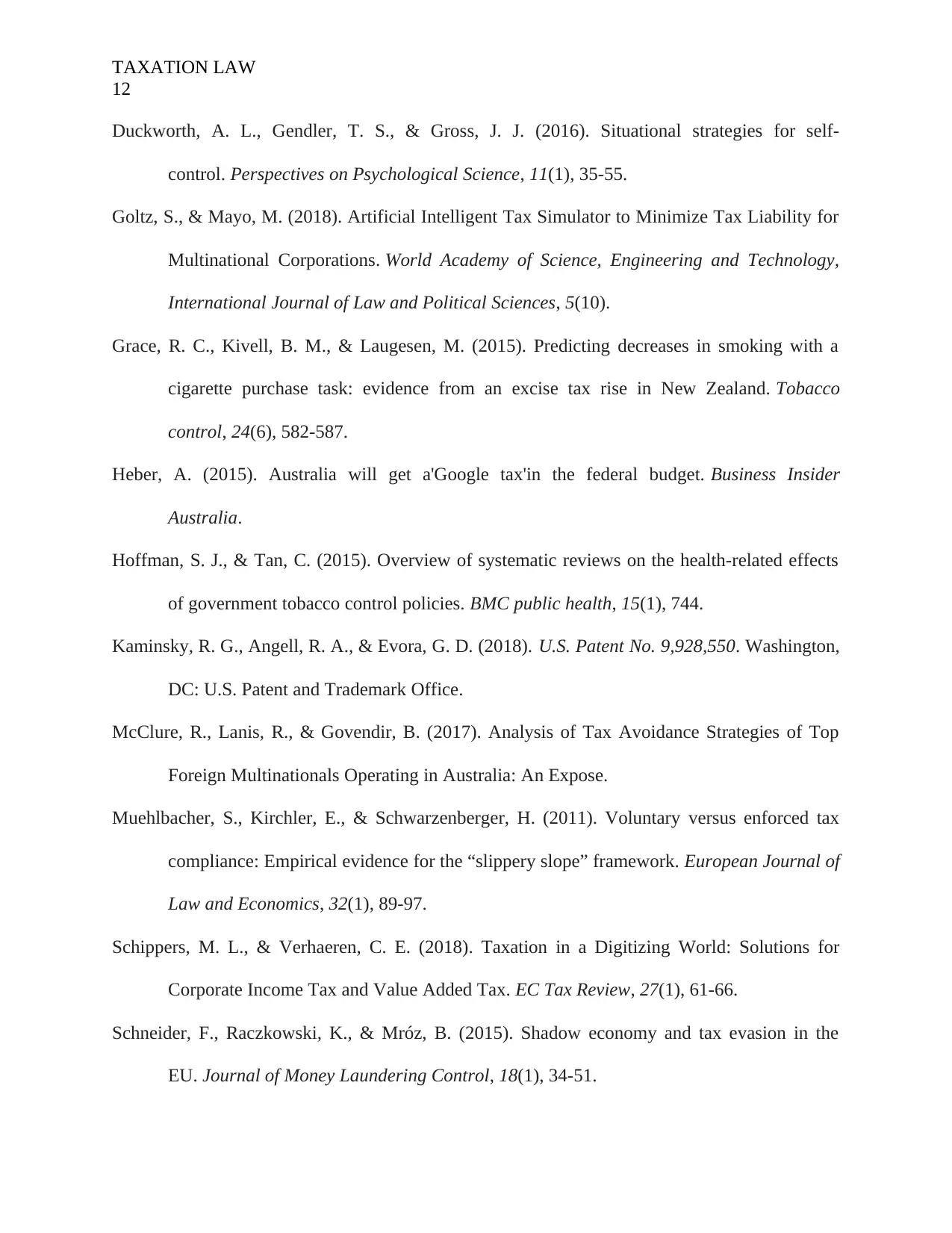
TAXATION LAW
12
Duckworth, A. L., Gendler, T. S., & Gross, J. J. (2016). Situational strategies for self-
control. Perspectives on Psychological Science, 11(1), 35-55.
Goltz, S., & Mayo, M. (2018). Artificial Intelligent Tax Simulator to Minimize Tax Liability for
Multinational Corporations. World Academy of Science, Engineering and Technology,
International Journal of Law and Political Sciences, 5(10).
Grace, R. C., Kivell, B. M., & Laugesen, M. (2015). Predicting decreases in smoking with a
cigarette purchase task: evidence from an excise tax rise in New Zealand. Tobacco
control, 24(6), 582-587.
Heber, A. (2015). Australia will get a'Google tax'in the federal budget. Business Insider
Australia.
Hoffman, S. J., & Tan, C. (2015). Overview of systematic reviews on the health-related effects
of government tobacco control policies. BMC public health, 15(1), 744.
Kaminsky, R. G., Angell, R. A., & Evora, G. D. (2018). U.S. Patent No. 9,928,550. Washington,
DC: U.S. Patent and Trademark Office.
McClure, R., Lanis, R., & Govendir, B. (2017). Analysis of Tax Avoidance Strategies of Top
Foreign Multinationals Operating in Australia: An Expose.
Muehlbacher, S., Kirchler, E., & Schwarzenberger, H. (2011). Voluntary versus enforced tax
compliance: Empirical evidence for the “slippery slope” framework. European Journal of
Law and Economics, 32(1), 89-97.
Schippers, M. L., & Verhaeren, C. E. (2018). Taxation in a Digitizing World: Solutions for
Corporate Income Tax and Value Added Tax. EC Tax Review, 27(1), 61-66.
Schneider, F., Raczkowski, K., & Mróz, B. (2015). Shadow economy and tax evasion in the
EU. Journal of Money Laundering Control, 18(1), 34-51.
12
Duckworth, A. L., Gendler, T. S., & Gross, J. J. (2016). Situational strategies for self-
control. Perspectives on Psychological Science, 11(1), 35-55.
Goltz, S., & Mayo, M. (2018). Artificial Intelligent Tax Simulator to Minimize Tax Liability for
Multinational Corporations. World Academy of Science, Engineering and Technology,
International Journal of Law and Political Sciences, 5(10).
Grace, R. C., Kivell, B. M., & Laugesen, M. (2015). Predicting decreases in smoking with a
cigarette purchase task: evidence from an excise tax rise in New Zealand. Tobacco
control, 24(6), 582-587.
Heber, A. (2015). Australia will get a'Google tax'in the federal budget. Business Insider
Australia.
Hoffman, S. J., & Tan, C. (2015). Overview of systematic reviews on the health-related effects
of government tobacco control policies. BMC public health, 15(1), 744.
Kaminsky, R. G., Angell, R. A., & Evora, G. D. (2018). U.S. Patent No. 9,928,550. Washington,
DC: U.S. Patent and Trademark Office.
McClure, R., Lanis, R., & Govendir, B. (2017). Analysis of Tax Avoidance Strategies of Top
Foreign Multinationals Operating in Australia: An Expose.
Muehlbacher, S., Kirchler, E., & Schwarzenberger, H. (2011). Voluntary versus enforced tax
compliance: Empirical evidence for the “slippery slope” framework. European Journal of
Law and Economics, 32(1), 89-97.
Schippers, M. L., & Verhaeren, C. E. (2018). Taxation in a Digitizing World: Solutions for
Corporate Income Tax and Value Added Tax. EC Tax Review, 27(1), 61-66.
Schneider, F., Raczkowski, K., & Mróz, B. (2015). Shadow economy and tax evasion in the
EU. Journal of Money Laundering Control, 18(1), 34-51.
⊘ This is a preview!⊘
Do you want full access?
Subscribe today to unlock all pages.

Trusted by 1+ million students worldwide
1 out of 13
Related Documents
Your All-in-One AI-Powered Toolkit for Academic Success.
+13062052269
info@desklib.com
Available 24*7 on WhatsApp / Email
![[object Object]](/_next/static/media/star-bottom.7253800d.svg)
Unlock your academic potential
Copyright © 2020–2025 A2Z Services. All Rights Reserved. Developed and managed by ZUCOL.




